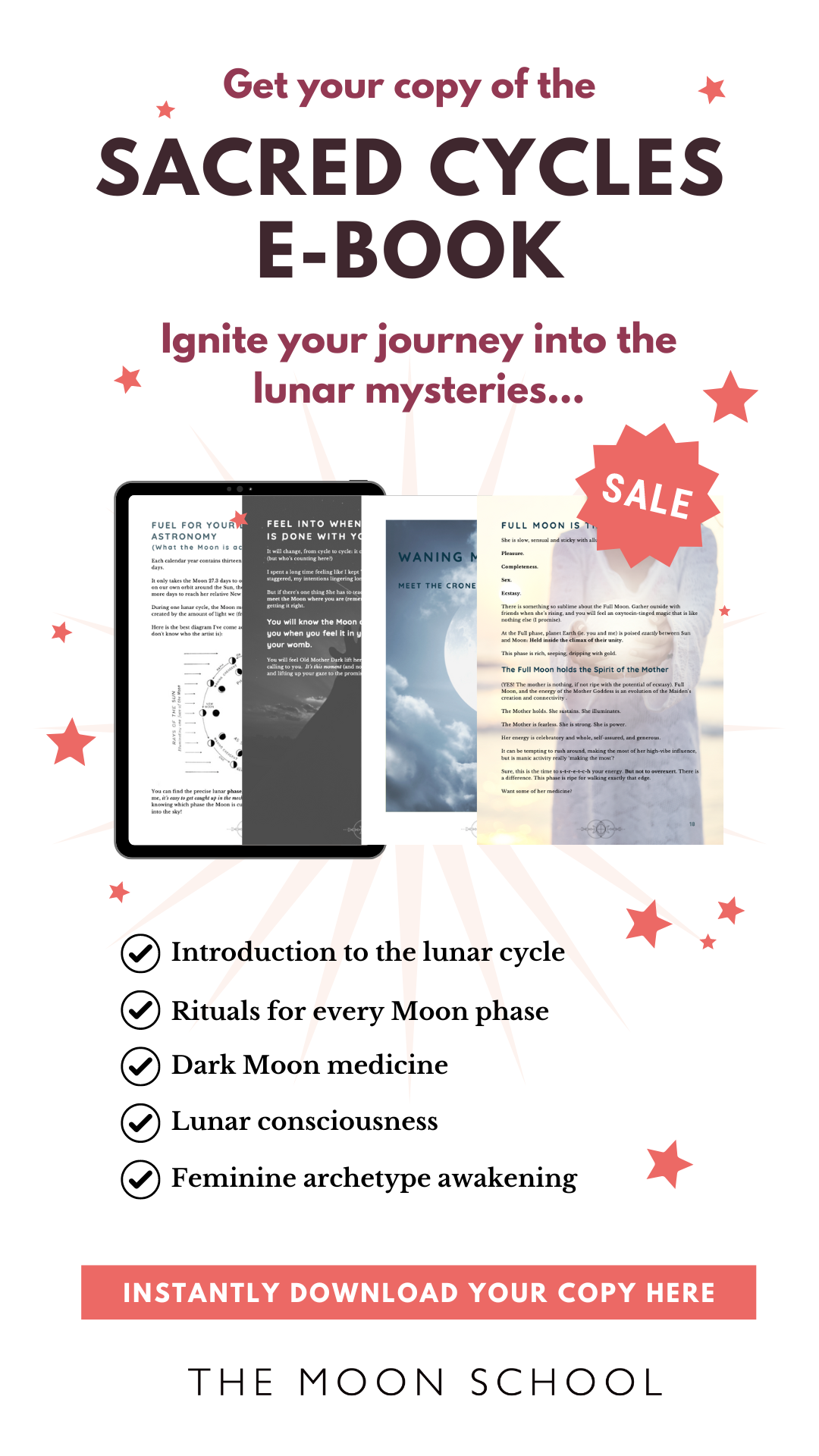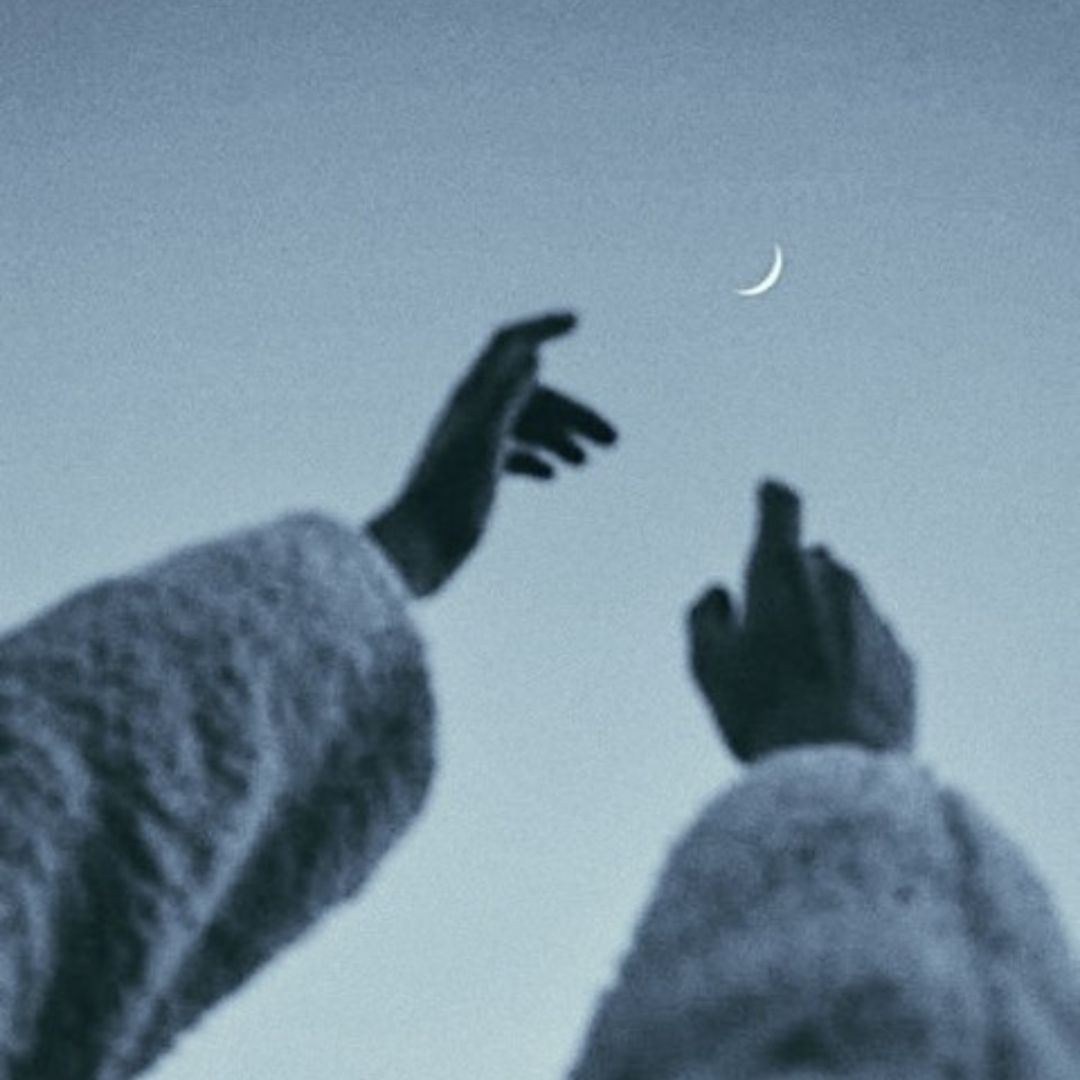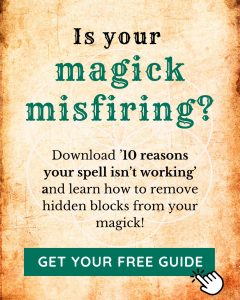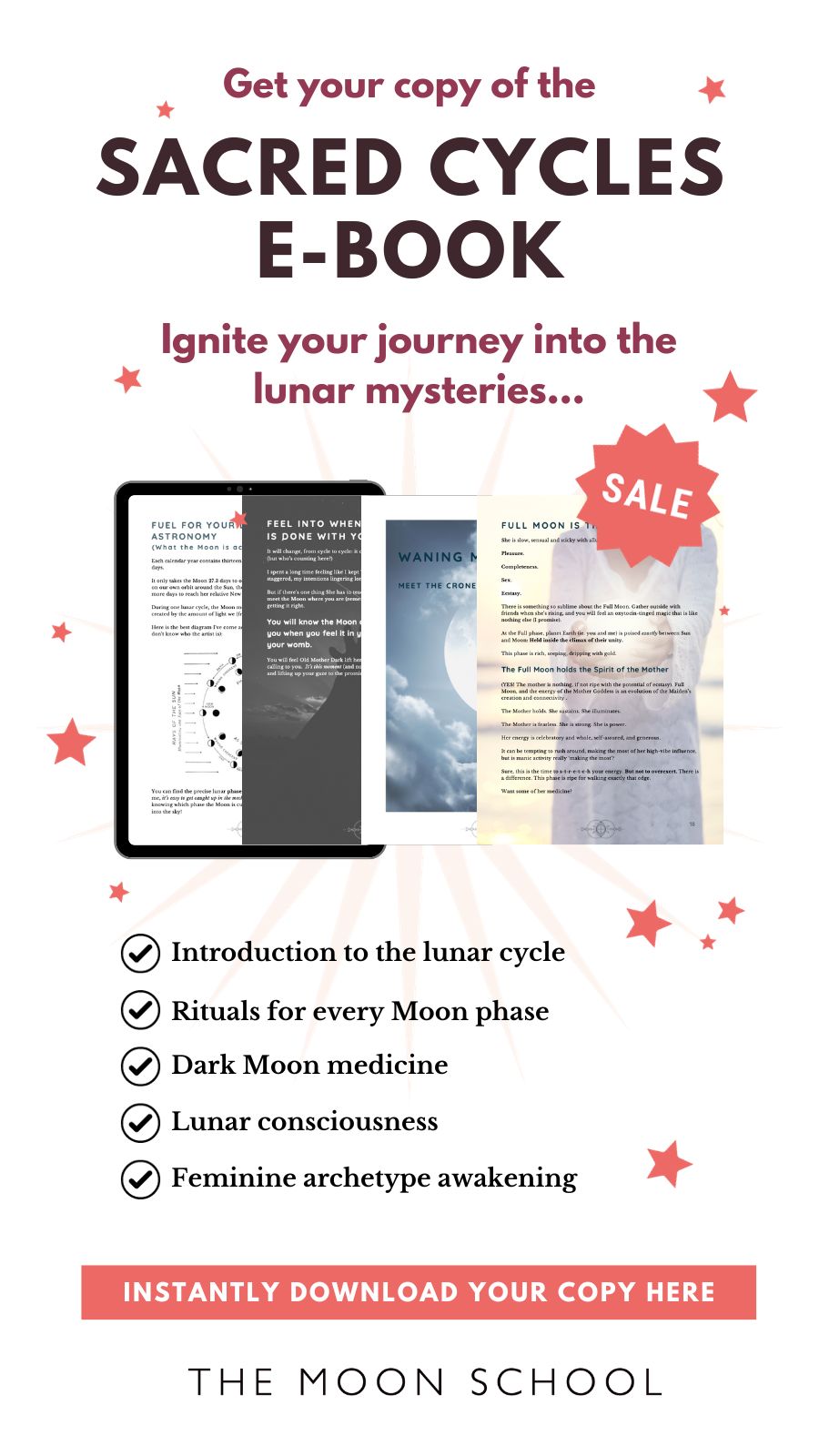The term ‘white Moon cycle’ describes a menstrual cycle where a woman bleeds with the new Moon and ovulates with the full Moon.
The white Moon cycle is experienced by a lot of women, and historically it’s believed it was far more common than it is today.
Yet white Moon cycles are something people are still seeking “proof” for.
While there are only pieces of scientific evidence to support the connection between the lunar cycle and the menstrual cycle, many women know there’s a connection.
If you’re curious, then start tracking your period, your moods and emotions in relation to the lunar cycles. See what correlation you discover, and see how this changes through the seasons too.
Because if there’s one thing we do know, it’s that women are flowing, ever-changing, beautiful instruments of growth and retreat. As soon as you stick us (and our menstrual cycles) in a box, we’ll do what we can to break out of it!
Yet our bodies do follow rhythms and patterns. Working consciously with your menstrual cycle can be a powerful tool for health and alignment with a better, more fulfilling kind of life.
However, many people still don’t know how to work with this cycle effectively. Menstruation is still clouded in shame for a lot of women, which prevents us from liberating the power we hold!
This article is one more attempt to shake off the generations of silence around our sacred blood cycles, so we can embrace our true feminine essence
How does the moon affect women’s menstrual cycle?
After analysing 7.5 million menstrual cycles, a recent study by period tracking app Clue found there’s no correlation between the Moon cycle and the female menstrual cycle.
“Looking at the data, we saw that period start dates fall randomly throughout the month, regardless of the lunar phase.” Says Dr. Marija Vlajic Wheeler.
Pretty compelling, eh? Yet I would ask how many of those women’s cycles were also affected by:
- Stress
- Weight gain or loss
- Exercise routine or level of physical activity
- Nutrition and diet
- Sleep patterns
- Underlying medical conditions (e.g. PCOS)
- Medications, including birth control pills
- Age
- Artificial light and exposure to narrow light spectrums (i.e blue light)
- Travel or changes in time zones
- Consumption of caffeine, alcohol, or other substances
- Pregnancy or postpartum period
- Menopause transition
- Breastfeeding
- Environmental toxins or chemicals
The menstrual cycle can be heavily influenced by both lifestyle and biological/medical conditions. In the modern world, most women are constantly bombarded by many factors which can upset any potential correlation between menstruation and the Moon.
When you begin to strip back these factors (eg. coming off hormonal birth control, minimizing screen time, eliminating toxic cleaning products) you may start to notice your body rhythms synching with the Moon.
Phases of the Moon
To understand the white Moon cycle, let’s first look at the Moon cycle as a whole. Our Moon goes through a series of phases, caused by its orbit around the Earth. These phases result from the relative positions of the Earth, Moon, and Sun.
Moon cycles are often separated up into four distinct phases, which are:
One lunar cycle lasts approximately 29.5 days. This is the time it takes for the moon to orbit the Earth.
It’s NO coincidence a woman’s menstrual cycle also lasts between 25 and 31 days!
But there are more similarities than just cycle length.
As a menstruating woman, you’ve probably experienced the changing phases of your own cycle, that touch you on physical, emotional, mental and spiritual levels.
These can also be separated into four distinct phases:
- Bleeding / menstrual phase
- Pre-ovulation / follicular phase
- Ovulation phase
- Pre-menstrual / luteal phase
What’s the connection between the Moon cycle and menstruation?
Despite science’s “evidence” to the contrary, most women know there is an un-doubtable correlation between the four phases of the lunar cycle and the four stages of the average menstrual cycle.
They are reflections of each other, the macrocosm echoing through the body of each menstruating female on the planet.
Of course not all women have the same cycle length – some have shorter or longer cycles, or even irregular cycles. And there’s a lot of modern-day interference with menstruation, such as the contraceptive pill, electric lighting, and of course, the EMFs emanating from the devices we keep in our pockets.
Yet the connection is still there.
And it’s important to realise that the distinct phases in each cycle don’t always align with each other in the same way.
You may bleed with the waxing, waning, or full Moon. Your luteal phase may fall on the waxing Moon or New Moon (or any other lunar phase).
This shifting rhythm creates the different menstruation moon cycles – the red Moon cycle and the white Moon cycle are the two most common, but there are others too.
Here’s the basic outline of the two most common menstruation Moon cycles.
White Moon cycle
- Menstrual / bleeding phase ⎜New Moon
- Pre-ovulation / follicular phase ⎜Waxing Moon
- Ovulation phase ⎜Full Moon
- Pre-menstrual / luteal phase ⎜Waning Moon
Red Moon cycle
- Menstrual / bleeding phase ⎜Full Moon
- Pre-ovulation / follicular phase⎜Waning Moon
- Ovulation phase⎜New Moon
- Pre-menstrual / luteal phase ⎜Waxing Moon
Understanding the White Moon Cycle
The white Moon cycle is a type of female cycle where a woman experiences menstruation during the new moon phase, and ovulation during the full moon.
So if you get your period around the dark Moon, or new Moon phase, then it means you have a white moon cycle.
If this is you, it means your cycle begins around the new Moon, and energetically, your white Moon cycle and the lunar cycle are closely aligned.
What does it mean when your period aligns with the new Moon?
When your menstrual phase occurs during the new Moon (or waning crescent, or dark Moon phases) it can signify a time of new beginnings and fresh starts on multiple levels. It’s auspicious for personal and spiritual rebirth when these natural cycles align.
Physically, you are bleeding, likely feeling tired and pretty slow and inactive. you may have lower back pain and pelvic cramps.
Your own emotional strength is at its lowest ebb, as is the energy of the Moon at this phase.
Also read: 10 Exquisite Effects of New Moon Energy
Your hormonal levels mean you are likely inwardly focused, preferring quiet time alone to socializing, and low lunar energy mirrors this tendency.
Energetically, this is a time for consciously releasing old, outmoded beliefs, attitudes, and behaviors, along with the bodily release of blood. It’s important to do this now, so that anything that no longer serves us is not carried with us over into the next cycle. The dark and waning crescent Moon phases support this.
Intuition is heightened – the two hemispheres of the brain are most actively communicating at this phase so intuitive insights and messages may be received.
As bleeding slows, it’s time to consciously set intentions for the new cycle, as you emerge from this time of retreat.
Read this post next: The Power of Darkness: Meaning of the Dark Moon Phase
For white Moon cycle women, their pre-ovulatory, or follicular phase coincides with the waxing Moon phases…
Physically, the pituitary glands release follicle-stimulating hormone (FSH), which is the signal the ovaries need to get ready to ovulate.
Physical and emotional energy is rising, and this is mirrored through the waxing Moon.
You likely feel more open to other people and to the possibilities around you.
Rising confidence enables you to attract more of what you desire into your life, and you likely feel more creative, and enthusiastic than you fave in a few weeks. This makes you eager to make plans and put them into action.
What does it mean when ovulation aligns with the full Moon?
When your ovulatory phase occurs during the Full Moon or waning gibbous phases, you’re at your strongest and most alert, whilst emotionally you are energized and confident!
This is typical Full Moon energy!
High, stable estrogen levels mean that you feel open, sociable, and communicative, and likely feel like getting together with friends and lovers.
As your most fertile and creative phase, this is the best time in your menstrual cycle to throw a party, go on dates, and schedule meetings. Because it’s also the Full Moon phase, other people are also experiencing these heightened, sociable vibes.
For white Moon cycle women, their luteal, or pre-menstrual phase coincides with the waning Moon phases. This marks a decline in physical and emotional energy, and towards the end of the cycle, premenstrual symptoms may appear.
You may become anxious, irritable, and defensive in an attempt to push others away, in order to create the space you need to be alone. This mirrors the waning Moon phases, as lunar energy is also retreating and the darkness grows.
You may feel the desire to perform self-care rituals, to restore and honor the body and aid in its natural cleansing and repair. Emotionally, these kinds of activities (long hot baths, massage, facials, manicures, etc.) help us to feel soothed and grounded.
Emotionally, at both your luteal phase and the waning Moon phase, it’s time to take stock and reflect on the cycle. This can result in either feeling proud of what you’ve achieved or disappointed in what you didn’t.
This reflection is valuable. It prepares you to strip back and release any aspects of yourself no longer desired or required, as you anticipate the release that comes with your next bleeding phase, and the next new Moon.
What’s the spiritual meaning of the white Moon cycle?
Spiritually, many people believe that women who menstruate during the new Moon phase are more “in sync” with the natural rhythms of the Earth and the Moon. This is because when the menstrual cycle and the lunar cycle correlate exactly, both cycles can enhance each other.
Spiritually, it’s believed the white Moon cycle emerges through the bodies of women who are in the peak of their own maternal energies. They are fertile, perhaps starting a family, or in the early stages of motherhood.
Women who bleed at the new Moon and ovulate at the full Moon are mirroring the creative, life-giving power of Mother Nature herself.
The full moon is associated with abundance, manifestation, and fertility. Women who ovulate at the full moon tend to embody these qualities – their bodies are ripe, open, and fertile! They are more available for creative expression, manifestation, and fertility rituals.
Also read: 33 Spiritual Things to Do on your Period
Then when the Moon is waning and getting dark, white Moon women are also retreating into their luteal and menstrual phases.
Because white Moon cycle women tend to be the nurturers and caregivers, they can spend a lot of their time and energy supporting others.
By synching menstruation with the lunar cycle, white Moon women are being held by the framework of her rhythms. Spiritually, this offers them the opportunity to rest more deeply at the waning Moon, and gather up the momentum of the waxing Moon phases too.
The white Moon cycle and the four female archetypes
The white Moon cycle closely mirrors the archetypal feminine cycle of Maiden – Mother – Wild Woman – Crone.
These four female archetypes are the most dominant in our lives as menstruating women, and they emerge through the lunar cycle, the seasons of the year, and the seasons of womanhood.
This is how the pattern looks:
- Maiden archetype: Pre-ovulation or follicular phase⎜waxing Moon ⎜spring season
- Mother archetype Ovulation phase⎜full Moon⎜summer season
- Wild woman archetype luteal or pre-menstrual phase⎜waning Moon⎜autumn/ fall season
- Crone Dark or new Moon⎜menstrual phase⎜winter season
Read this post next: What are the Four Female Archetypes (and How to Work With Them)
Which is better, white Moon cycle or red Moon cycle?
It’s really important not to get stuck in thinking that one menstrual cycle is “better” than another. The white Moon cycle isn’t some holy grail of menstruation, that we all need to be aiming for! (Sounds crazy, but this really is what some women believe).
All menstrual cycles are a combination of spiritual, emotional, hormonal, biological and even ancestral patterning.
Each woman’s experience is unique and holds vital pieces of information for us. So it’s important for women to honor their own bodies and cycles in a way that feels authentic and empowering to them. Don’t wish yours away.
5 Tips for working with your white Moon cycle
If you’re one of the many women with a white Moon cycle, you can work with it to enhance your health and well-being. Here are 5 tips
1. Track your cycle
Keeping track of your menstrual cycle using a calendar or app can help you understand the patterns and changes in your body.
You’ll also be able to anticipate not only your periods but each stage of your cycle, so you can plan accordingly.
During the new moon, when estrogen levels are low, it is a good time to rest, reflect, and set an intention for the upcoming cycle.
As estrogen levels increase during the waxing moon, you may experience a surge in energy and creativity, making this a good time to tackle new projects and set goals.
As the full moon approaches and estrogen levels peak, you’ll likely feel more sensual and passionate. This is a good time to connect with your partners and explore your sexuality.
You may also like: The 13 Seduction Archetypes: How to Harness your Raw Femininity
As the Moon wanes, and you enter your luteal phase, you’ll likely need more space and time to yourself. If you don’t get it, that’s when PMS will likely strike.
2. Honor your body’s needs
During your menstrual phase, your body may need more rest and self-care. And during your follicular and ovulatory phases, you’ll have more energy to burn!
Listen to your body, and do what she tells you, when she tells you.
3. Set boundaries
If you’re a mother or primary caregiver, setting boundaries is one of the best ways you can harness the power of your white Moon cycle.
It’s not always easy. But try to ensure your “no” means no, and that you set aside enough time and energy for the different needs you have at each stage of your cycle.
PMS usually hits NOT because we are premenstrual, but because we’re not getting what we need during the premenstrual phase. Think about that.
Learn to communicate your needs clearly, with kindness and certainty (and if you don’t actually know what your needs are, then your first task is to go within and figure that out).
4. Embrace creativity
The white Moon cycle is a really creative cycle! You have the opportunity to harness all the waxing, creative, and imaginative energy of the Moon, alongside your internal flowering.
This is likely a time in your life for creative inspiration and new ideas. Engage in creative activities such as writing, painting, or crafting to tap into this energy. And bring it into your other daily activities too.
5. Practice self-reflection
You can really make the most of this cycle by dropping into self-reflection when the Moon is waning (and you are premenstrual).
Take time to journal, meditate, or engage in other practices such as shadow work, that will help you connect with your inner self and gain insight into your thoughts and emotions.
A couple of other Moon cycles…
Apart from the red and the white Moon cycle, there are a couple of other menstrual cycles to be aware of.
Pink Moon cycle
If you bleed during the waxing Moon phase, then you have what’s known as a pink Moon cycle, or a pink cycle.
This waxing lunar phase is emergent, growing, building, and becoming. Often women who have had a white Moon cycle will transition to this one, as they enter a new phase of their own self-realisation.
Purple Moon cycle
If you bleed during the waning Moon phase, then you have what’s known as a purple Moon cycle, or a purple cycle.
This lunar phase is disseminating, it’s about retreat, introspection, and integration. Often women who have had a red Moon cycle will transition to this one, as they’re ready to release aspects of themselves to make space for something new.
Your cycle? Read this: 5 Tips to Harness the Power of Your Purple Moon Cycle
How modern living can affect your menstrual cycle
The Moon has been a symbol of femininity and fertility for centuries. However, with modern life, our connection to the moon’s natural rhythms has been disrupted. Many women experience irregular cycles due to various factors, including artificial light and birth control.
Artificial light and menstrual cycles
Artificial light can have a significant impact on your menstrual cycle. Exposure to light at night can disrupt your circadian rhythm, which can affect your sleep patterns and hormone production. This disruption can lead to irregular periods, making it difficult to predict when your next period will occur.
To minimize the impact of artificial light on your menstrual cycle, try to limit your exposure to screens and bright lights at night. You can also invest in blackout curtains to create a darker sleeping environment.
Birth control and menstrual cycles
Birth control will affect your menstrual cycle.
Hormonal birth control methods, such as the pill, patch, or ring, can seem as though they are regulating your cycle, making your periods more predictable. However, what you experience when you bleed, is a false period. Artificial birth control is disrupting your body’s natural rhythm.











